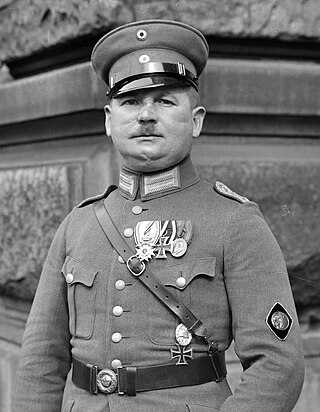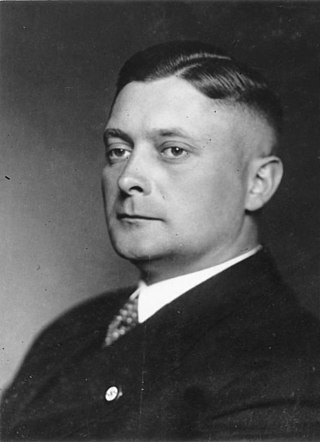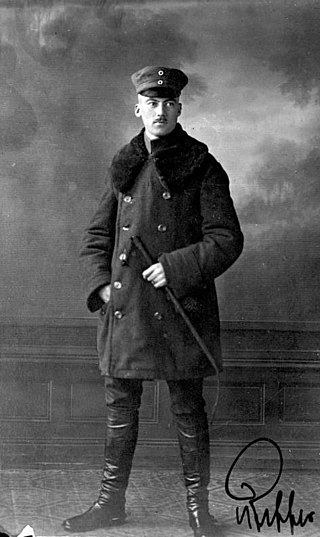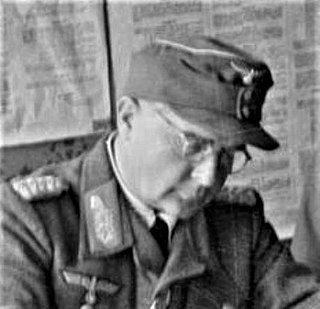
Paul Joseph Goebbels was a German Nazi politician and philologist who was the Gauleiter of Berlin, chief propagandist for the Nazi Party, and then Reich Minister of Propaganda from 1933 to 1945. He was one of Adolf Hitler's closest and most devoted followers, known for his skills in public speaking and his deeply virulent antisemitism which was evident in his publicly voiced views. He advocated progressively harsher discrimination, including the extermination of the Jews in the Holocaust.
The Sturmabteilung was the original paramilitary wing of the Nazi Party. It played a significant role in Adolf Hitler's rise to power in the 1920s and early 1930s. Its primary purposes were providing protection for Nazi rallies and assemblies, disrupting the meetings of opposing parties, fighting against the paramilitary units of the opposing parties, especially the Roter Frontkämpferbund of the Communist Party of Germany (KPD) and the Reichsbanner Schwarz-Rot-Gold of the Social Democratic Party of Germany (SPD), and intimidating Romani, trade unionists, and especially Jews.

Ernst Julius Günther Röhm was a German military officer and a leading member of the Nazi Party. Initially a close friend and early ally of Adolf Hitler, Röhm was the co-founder and leader of the Sturmabteilung (SA), the Nazi Party's original paramilitary wing, which played a significant role in Adolf Hitler's rise to power. He served as chief of the SA from 1931 until his murder in 1934 during the Night of the Long Knives.

The Reichstag fire was an arson attack on the Reichstag building, home of the German parliament in Berlin, on Monday, 27 February 1933, precisely four weeks after Adolf Hitler was sworn in as Chancellor of Germany. Marinus van der Lubbe, a Dutch council communist, was the culprit; the Nazis attributed the fire to a group of Communist agitators, used it as a pretext to claim that Communists were plotting against the German government, and induced President Paul von Hindenburg to issue the Reichstag Fire Decree suspending civil liberties, and pursue a "ruthless confrontation" with the Communists. This made the fire pivotal in the establishment of Nazi Germany.

Gregor Strasser was a German politician and early leader of the Nazi Party. Along with his younger brother Otto, he was a leading member of the party's left-wing faction, which brought them into conflict with the dominant faction led by Adolf Hitler, resulting in his murder in 1934. The brothers' strand of the Nazi ideology is known as Strasserism.

Karl August Hanke was an official of the Nazi Party (NSDAP) during its rule over Germany who served as the fifth and final Reichsführer of the Schutzstaffel (SS). He also served as Gauleiter of Gau Lower Silesia from 1941 to 1945 and as Oberpräsident of the Prussian Province of Lower Silesia. Captured on 6 May 1945, he was shot and wounded during an escape attempt and then beaten to death by Czech guards on 8 June, after the war had ended.

Karl Kaufmann was a German politician who served as a Nazi Party Gauleiter from 1925 to 1945 and as the Reichsstatthalter of Hamburg from 1933 to 1945.

Franz Pfeffer von Salomon during the Nazi regime known as Franz von Pfeffer, was the first Supreme Leader of the Sturmabteilung (SA) after its re-establishment in 1925. Pfeffer resigned from his SA command in 1930 and was expelled from the Nazi Party in 1941. He died in 1968.
The Bamberg Conference included some sixty members of the leadership of the Nazi Party, and was specially convened by Adolf Hitler in Bamberg, in Upper Franconia, Germany on Sunday 14 February 1926 during the "wilderness years" of the party.

Adolf Hitler's rise to power began in the newly established Weimar Republic in September 1919 when Hitler joined the Deutsche Arbeiterpartei. He rose to a place of prominence in the early years of the party. Being one of its most popular speakers, he was made the party leader after he threatened to otherwise leave.

Otto Wilhelm Heinrich Wagener was a German professional military officer and Nazi Party official. He was a member of the Nazi paramilitary unit, the Sturmabteilung, rising to become its effective leader as the first SA-Stabschef from 1929 to 1930. At the start of the Nazi regime, he served as Adolf Hitler's chief economic advisor. He survived the Röhm purge of SA leaders in 1934 and returned to military service in the Second World War, becoming a Generalmajor and military governor of the Italian Dodecanese islands. Following the war, he was interned, put on trial in Italy and sentenced to prison for war crimes.

Edmund Heines was a German Nazi politician and Deputy to Ernst Röhm, the Stabschef of the Sturmabteilung (SA). Heines was one of the earliest members of the Nazi Party and a leading member of the SA in Munich, participating in the Beer Hall Putsch and becoming a notorious enforcer of the party. He held several high-ranking positions in the Nazi administration until he was executed during the Night of the Long Knives in June 1934.

Der Angriff was the official newspaper of the Berlin Gau of the Nazi Party. Founded in 1927, the last edition of the newspaper was published on 24 April 1945.

The Stennes revolt was a revolt within the Nazi Party in 1930 through 1931 led by Walter Stennes, the Berlin commandant of the Sturmabteilung (SA), the Nazi's "brownshirt" storm troops. The revolt arose from internal tensions and conflicts within the Nazi Party of Germany, particularly between the party organization headquartered in Munich and Adolf Hitler on the one hand, and the SA and its leadership on the other hand. There is some evidence suggesting that Stennes may have been paid by the government of German chancellor Heinrich Brüning, with the intention of causing conflict within and destabilizing the Nazi movement.
Kurt Lüdecke was an ardent German nationalist and international traveler who joined the Nazi Party in the early 1920's and who used his social connections to raise money for the NSDAP. Before attending a rally at which Adolf Hitler was a featured speaker, Lüdecke had assumed that Hitler was simply "one more fanatic" but after hearing Hitler speak at a mass demonstration at the Königsplatz in Munich, he adopted Hitler as his hero: "His appeal to German manhood was like a call to arms, the gospel he preached a sacred truth." The next day, he spoke to Hitler for four hours and offered himself to Hitler and the Nazi cause "without reservation ... I had given him my soul."
Emil Holtz was an early Nazi Party official who served as Gauleiter of Gau Brandenburg from 1928 to 1930.

Erich Schmiedicke was a German Nazi Party official and politician.

The Röhm scandal resulted from the public disclosure of Nazi politician Ernst Röhm's homosexuality by anti-Nazis in 1931 and 1932. As a result of the scandal, Röhm became the first known homosexual politician.
The National Socialist Working Association, sometimes translated as the National Socialist Working Community was a short-lived group of about a dozen Nazi Party Gauleiter brought together under the leadership of Gregor Strasser in September 1925. Its full name was the Arbeitsgemeinschaft der nord- und westdeutschen Gaue der NSDAP. Aligned with the Strasserist wing of the Party, it unsuccessfully sought to steer the Party leadership in that direction by updating the Party program of 1920. Party Chairman Adolf Hitler perceived the Association as a threat to his leadership, so its activities were curtailed shortly after the Bamberg Conference of 14 February 1926 presided over by him, and it was formally dissolved on 1 October of that year.














